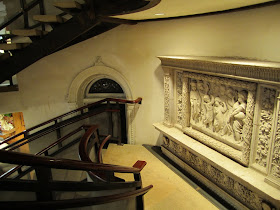




I spent some time on google maps yesterday, cruising around Mill Neck, Long Island at low altitude. (How great is google maps?) Conventional wisdom has it that Long Island has been completely ruined by development, but whoever said that obviously hasn't been to Mill Neck. Long Island is on my mind because of my next "Old House" article for the "Millbrook Independent." I'm writing about a charming Greek Reveval style house owned for 50 years by Mabel Brady Garvan. She only used it as a hunting box, because she mostly lived at 740 Park Avenue, and at a big place on the Island called Roslyn House, which she and her husband, Francis P. Garvan bought in 1919 from Stanley Mortimer. The first image is a postcard view of Roslyn House from the era when rich people didn't mind having views of their houses sold in local drug stores. Located just west of the Old Westbury Country Club golf course, the estate was chopped into a zillion lots and the mansion demolished in 1974. Years ago I saw an evocative aerial photo of the Meadow Brook Hounds streaming across the lawn of this place on one of their final hunts, red coated field in hot pursuit, a line of splanches from a new housing development clearly visible in the distance. The other 4 images are of two very grand houses currently for sale in my neighborhood. The 2nd and 3rd are of 18 East 68th St., 36' wide, built in 1905, and supposedly in very good private house condition. It was listed in 2008 for $64 million, and is now reduced to $39 million. The final photos are of 22 East 71st St., a whopping 45' wide, with 21,000 sq. ft. of interior space. This house has brilliant public rooms and an amazing staircase, but has also suffered a lot of institutional alteration. It sold for $19.5M in 2004, recently went back on the market for $75M, and is now down to $59M.

















































